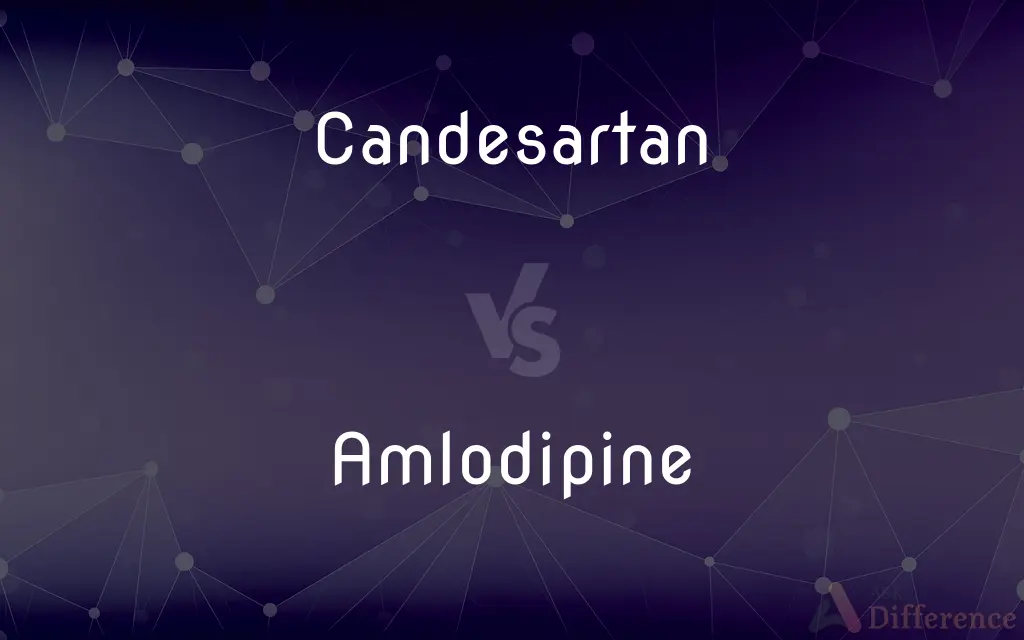Candesartan vs. Amlodipine — What's the Difference?
By Urooj Arif & Fiza Rafique — Updated on March 13, 2024
Candesartan is an angiotensin receptor blocker (ARB), while amlodipine is a calcium channel blocker (CCB).

Difference Between Candesartan and Amlodipine
Table of Contents
ADVERTISEMENT
Key Differences
Candesartan works by blocking the action of angiotensin II, leading to vasodilation , whereas amlodipine inhibits calcium ions from entering vascular smooth muscle and cardiac cells, resulting in decreased vascular resistance and lower pressure.
While candesartan is often used for heart failure and hypertension, amlodipine is preferred for hypertension, angina, and sometimes for coronary artery disease.
Candesartan's side effects may include dizziness and renal impairment, while amlodipine can cause edema, fatigue, and palpitations.
These medications are chosen based on individual patient profiles, considering their specific effects on the cardiovascular system and potential side effects.
Comparison Chart
Classification
Angiotensin II receptor blocker (ARB).
Calcium channel blocker (CCB).
ADVERTISEMENT
Mechanism of Action
Blocks the action of angiotensin II, reducing BP by preventing vasoconstriction.
Inhibits calcium ions from entering vascular smooth muscle and cardiac cells, leading to vasodilation.
Primary Use
Hypertension, heart failure.
Hypertension, angina, coronary artery disease.
Common Side Effects
Dizziness, renal impairment.
Edema, fatigue, palpitations.
Considerations
May be preferred in patients with certain renal conditions or diabetes.
Often chosen for its effectiveness in angina and its vasodilatory effects on peripheral vessels.
Compare with Definitions
Candesartan
Includes dizziness, headaches, and potential renal function impairment.
Some patients on candesartan experience dizziness as a side effect.
Amlodipine
Helps to alleviate symptoms of angina by improving blood flow to the heart muscle.
Patients with angina may find relief from chest pain with amlodipine treatment.
Candesartan
Used to treat heart failure, improving symptoms and survival rates.
For heart failure patients, candesartan can help reduce the strain on the heart.
Amlodipine
A common side effect due to the dilation of vessels.
Amlodipine can cause swelling in the feet and ankles as a side effect.
Candesartan
Not recommended for patients with known hypersensitivity or certain renal artery conditions.
Candesartan is contraindicated in patients with bilateral renal artery stenosis.
Amlodipine
Besides hypertension, it's used for coronary artery disease and chronic stable angina.
Amlodipine is versatile, also prescribed for conditions like coronary artery disease.
Candesartan
May offer protection against renal deterioration in hypertensive patients.
Candesartan is often chosen for patients with hypertension and chronic kidney disease.
Amlodipine
Known for its long half-life, allowing once-daily dosing.
The long-acting nature of amlodipine supports adherence with once-daily dosing.
Candesartan
(pharmaceutical drug) An angiotensin receptor antagonist used for the treatment of hypertension
Amlodipine
(pharmaceutical drug) A long-acting calcium channel blocker used as an anti-hypertensive and in the treatment of angina
Common Curiosities
Is amlodipine suitable for patients with diabetes?
Amlodipine can be used in diabetic patients, but it's essential to monitor for any potential fluid retention.
Are there any dietary restrictions when taking candesartan or amlodipine?
While specific dietary restrictions are minimal, it's generally advised to maintain a balanced diet and avoid excessive potassium intake with ARBs like candesartan.
How do the side effects of candesartan and amlodipine differ?
Candesartan can cause dizziness and renal impairment, whereas amlodipine may lead to edema, fatigue, and palpitations.
Does amlodipine affect heart rate?
Amlodipine does not typically have a significant effect on heart rate, unlike some other calcium channel blockers.
Can amlodipine cause weight gain?
While not common, some patients may experience weight gain due to fluid retention associated with amlodipine.
What are the long-term effects of taking amlodipine?
Amlodipine is generally safe for long-term use, but monitoring is recommended for any potential side effects like edema.
Can candesartan be used in pregnancy?
Candesartan is generally not recommended during pregnancy due to the risk of harm to the developing fetus.
Who should not take candesartan?
Patients with bilateral renal artery stenosis or hypersensitivity to ARBs should avoid candesartan.
Is cough a side effect of candesartan?
Cough is less commonly associated with ARBs like candesartan compared to ACE inhibitors.
How quickly does candesartan work?
Candesartan starts lowering blood pressure within hours of the first dose, with maximum effects seen within several weeks.
Share Your Discovery

Previous Comparison
Apocalypse vs. Cataclysm
Next Comparison
Sympathy vs. CompassionAuthor Spotlight
Written by
Urooj ArifUrooj is a skilled content writer at Ask Difference, known for her exceptional ability to simplify complex topics into engaging and informative content. With a passion for research and a flair for clear, concise writing, she consistently delivers articles that resonate with our diverse audience.
Co-written by
Fiza RafiqueFiza Rafique is a skilled content writer at AskDifference.com, where she meticulously refines and enhances written pieces. Drawing from her vast editorial expertise, Fiza ensures clarity, accuracy, and precision in every article. Passionate about language, she continually seeks to elevate the quality of content for readers worldwide.














































